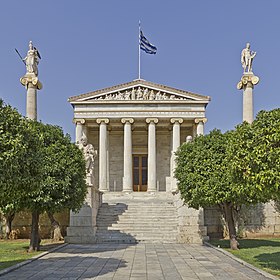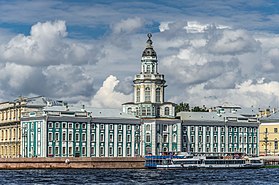Academy
Academy (from the Latin academia, and this in turn from the Greek Ακαδημία -Akademía-) is a term that identifies various institutions cultural or educational. The Dictionary of the Spanish language defines it as scientific, literary or artistic society established with public authority and as educational establishment, public or private, of a professional, artistic, technical, or simply practical, in addition to identifying the term with the meeting of its components (the academics) and with the building that houses it.
"Academic disciplines" It is the denomination given to the different fields of knowledge that are investigated and taught in the university environment.
Old Age
Originally, it was the name of an educational institution in classical Athens: the Academy founded by Plato, which owed its name to a legendary hero of Greek mythology, Academus. It was located in the demo of Kolonos, one kilometer northwest of the city, on land acquired by Plato around 384 BC. C., where there was an olive grove, a park and a gym. The instruction given there included the study of mathematics, dialectic, and the natural sciences. There were other similar institutions in antiquity, such as the Aristotelian Lyceum; although none was called The School of Athens , title of one of Raphael's frescoes in the Vatican rooms where the wise men of Antiquity are depicted uchronically with the faces of his contemporaries (1510-1512). The scientific institutions of ancient Alexandria (Museum, Library) or the meetings of intellectuals of ancient Rome (such as those of the circle of Maecenas or those of the court of Augustus, or the Athenaeum or "Roman school" of Hadrian), which to some extent shared functions with those, are sometimes called "academies", although it is not usual. The Platonic Academy and the other cultural institutions considered "pagan" by the Christians they subsisted until the year 529 when the Byzantine emperor Justinian I ordered its closure.
Middle Ages
In the Middle Ages, the word "academy" came to designate, in Latin Christianity, the body of teachers who, meeting with students in a certain place (the schola -monastic school, cathedral school, palatine school- or studium -Studium Generale-) where a branch of teaching was professed, especially what in the medieval university was called major faculty. The Goliardesque poem Gaudeamus igitur, which has become a university anthem, includes an explicit vivat academia.
Modern Age
In the Renaissance the Florentine Platonic Academy was founded (1440, Cosimo I de' Medici, Marsilio Ficino, Pico della Mirandola, etc.). From it, the idea of academy spread as a cultural institution where, outside the scope of the university, which had become stagnant in scholasticism, contact and exchange of ideas between the multiplicity of disciplines was made possible. intellectuals that included the new concept of humanist (philologists, poets, artists, scientists -conditions that often coincided in the same person-). They were essential for the beginning of modernity that led to the scientific revolution of the XVII century: the Linceana Academy in Rome (Federico Cesi, 1601-1630), the Accademia del Cimento in Florence (Evangelista Torricelli, Giovanni Borelli, 1657-1667 -cimento means "experiment", and its motto was Testing and failing-), the English Royal Society (1660), the French Academy of Sciences in Paris (1666) (the latter two represented two models alternative forms of organization: while the English one was a private club whose members paid dues, the French one was a public institution paid by the State); and the Academy of Arcadia (1690) in Rome. Leibniz's activity promoted the creation of scientific academies in Berlin, Saint Petersburg, Dresden, and Vienna.
In the Spain of the Golden Age, numerous literary and other scientific academies flourished, such as the Academy of Mathematics of Madrid or Royal Mathematical Academy (1582) and the Royal Academy of Medicine and Surgery of Seville (1693) and artistic, such as the Academy of San Lucas (1603-1626). In 1609 Lope de Vega read his New art of making comedies before a so-called Madrid Academy (one of the many existing literary circles).. The foundation of academies spread to such an extent, that Miguel de Cervantes mocks it with the fictitious Argamasilla academics that appear at the end of Don Quixote .
From the activity of the French academy in Rome (1666) the concept of academicism ended up being associated with a certain conception of art and aesthetics: the identification of beauty with mimesis (imitation of nature), and the conception of apprenticeship of the artist's trade in an "academic" environment, that is, in an institution subject to a formal program with subjects and professors (compared to union apprenticeship in traditional workshops), based on the reproduction of classic models and subjection to the rules of art. Academicism was expressed in the artistic styles called classicism (17th century) and neoclassicism (18th and 19th centuries), as opposed to contemporary styles (baroque and romanticism).
Contemporary Age
From the Contemporary Age, the term "academy", is used, generically, as a synonym of "intellectual world", especially to refer to the university (which has returned to occupy a central place in science and culture); but also artistic (like the Russian term Academichka).
In specific terms, it designates scientific, literary or artistic societies established with private or public sponsorship. Its role as an institution is the promotion of a cultural (literature, language, music, dance) or scientific activity (promotion of a science or a specific specialty). In some countries, the name academy is given to educational institutions of very different levels (from secondary education to various technical education, including military academies). The term "academic" Applied to people, on the other hand, it is usually reserved for those selected to form part of elite institutions (in France the five academies of the Institute of France, in Spain the eight Royal Academies, in England the Royal Academy and the British Academy, in the former USSR the Academy of Sciences of the Soviet Union, etc.).
Iconography
This gathering of learned men or men of letters who deal with work related to the progress of science and the arts is symbolized by a respectable woman whose temples are adorned with a golden crown; her dresses are iridescent in color; In her right hand she carries a file with this motto: Detrahit atque polit and in her left an interwoven garland of laurel, ivy and myrtle: three poetic plants that allude to heroic and lyrical poetry. and pastoral. There are also two pomegranates suspended from this garland, a symbol of union.
The matron is seated on a bench adorned with olive or cedar branches, both emblems of immortality. It can also be embellished with branches of cypress or oak, symbols of duration and immortality. The place of the scene is a delightful landscape; several books are piled up at her feet and some musical instruments announce that harmony is necessary to the arts.
Academy Awards
The name Academy Awards is given to various competitions, among which stand out for their importance, among others:
- the Nobel Prizesof the Nobel Foundation (Swedish Academy and Parliament of Norway).
- the Oscar Awards, of the Academy of Arts and Film Sciences of Hollywood.
Additional bibliography
- A. Leight DeNeef and Craufurd D. Goodwin, eds. The Academic's Handbook. 2nd ed. Durham and London: Duke University Press, 1995. (in English)
- Christopher J. Lucas and John W. Murry, Jr. New Faculty A practical Guide for Academic Beginners. New York: Modern Language Association, 1992. (in English)
- John A. Goldsmith, John Komlosk and Penny Schine Gold. The Chicago Guide to Your Academic Career. Chicago: University of Chicago Press, 2002. (in English)
- William Germano. Getting it Published: A Guide for Scholars (And Anyone Else)Serious about Serious Books. Chicago: University of Chicago Press, 2001. (in English)
- Kemp, Roger L. "Town and Gown Relations: A Handbook of Best Practices," McFarland and Company, Inc., Jefferson, North Carolina, USA, and London, England, UK (2013). (ISBN 978-0-7864-6399-2). (in English)
- Alan Cameron, "The last days of the Academy at Athens," in Proceedings of the Cambridge Philological Society vol 195 (n.s. 15), 1969, pp. 7–29. (in English)
- Gerald Bechtle, Bryn Mawr Classical Review of Rainer Thiel, Simplikios und das Ende der neuplatonischen Schule in Athen. Stuttgart, 1999 (in English)
- John Glucker, Antiochus and the Late AcademyGöttingen 1978. (in English)
- Francis Haskell and Nicholas Penny, 1981. Taste and the Antique: The Lure of Classical Sculpture, 1500–1900 (New Haven: Yale University Press) (in English)
Contenido relacionado
Monomer
Guanine
Universal Free Encyclopedia in Spanish





